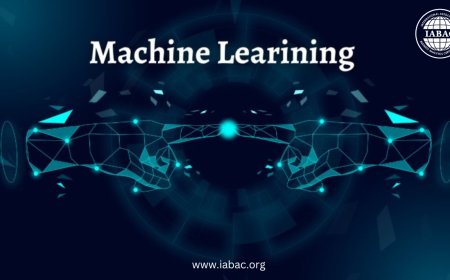Harnessing Machine Learning for Business Insights
Unlock unparalleled business insights with the transformative power of Machine Learning. Harness the potential of data-driven decision-making and gain a competitive edge in your industry.

In the era of digital transformation, businesses are increasingly turning to advanced technologies to gain a competitive edge. Among these technologies, Machine Learning (ML) stands out as a powerful tool for extracting valuable insights from vast datasets. As businesses generate and accumulate unprecedented amounts of data, the ability to harness this information becomes crucial.
The Rise of Machine Learning in Business
The rise of Machine Learning (ML) in business marks a paradigm shift in how organizations leverage data to make informed decisions. Traditionally, businesses relied on manual analysis and intuition to interpret data, a process often time-consuming and limited in its ability to handle large datasets. With the advent of ML, this landscape has been transformed. ML algorithms empower computers to discern patterns, correlations, and anomalies within massive datasets, allowing businesses to extract meaningful insights at unprecedented speed and scale.
One of the key reasons for the ascendancy of ML in business is its capacity to enhance customer-centric strategies. By analyzing vast amounts of customer data, ML algorithms can discern patterns in behavior, predict preferences, and recommend personalized experiences. This level of insight has revolutionized marketing and customer service, enabling businesses to tailor their approaches to individual customers and create more engaging and relevant interactions. From recommendation engines on e-commerce platforms to personalized marketing campaigns, ML is reshaping how businesses connect with their customers.
Moreover, ML's impact extends beyond customer interactions to internal operations. Businesses are increasingly turning to ML to optimize processes, reduce costs, and enhance overall efficiency. Predictive maintenance, for instance, uses ML algorithms to analyze historical data and predict when equipment is likely to fail, enabling proactive maintenance and minimizing downtime. This proactive approach not only saves costs but also ensures that operations remain uninterrupted, a crucial factor in industries where downtime can be financially detrimental.
The financial sector, too, has witnessed a substantial transformation with the integration of ML. From risk management to fraud detection, ML algorithms are adept at analyzing intricate financial datasets to identify patterns that might elude human analysts. This not only enhances the security of financial transactions but also aids in making more informed investment decisions. The ability to predict market trends and assess risks has positioned ML as an invaluable tool in the financial decision-making processes of many institutions.
Customer-Centric Insights
In the contemporary business environment, understanding and responding to customer needs is pivotal for success. The concept of customer-centricity revolves around placing the customer at the core of business strategies, and Machine Learning (ML) plays a vital role in achieving this goal. ML algorithms are adept at processing vast amounts of customer data, enabling businesses to glean profound insights into consumer behavior, preferences, and trends.
One key application of ML in generating customer-centric insights is through the analysis of purchasing patterns. By examining historical transaction data, ML algorithms can identify subtle patterns that may not be immediately apparent to human analysts. This allows businesses to anticipate customer needs, preferences, and potential future purchases. For instance, if a customer frequently purchases a particular set of products, ML algorithms can predict related items that might be of interest, facilitating the creation of personalized recommendations.
Moreover, customer-centric insights derived from ML can significantly enhance marketing strategies. ML algorithms can segment customers based on their behaviors and preferences, enabling businesses to tailor marketing campaigns for specific demographic groups. This targeted approach not only improves the effectiveness of marketing efforts but also enhances customer engagement by delivering more relevant and personalized content.
The real-time nature of ML also contributes to customer-centricity. By analyzing data as it is generated, businesses can respond promptly to changing customer behaviors. For example, if a sudden surge in interest for a particular product or service is detected, ML algorithms can trigger automated responses such as personalized promotions or notifications, fostering a dynamic and responsive customer experience.
Operational Efficiency and Predictive Maintenance
Operational Efficiency
Operational efficiency refers to the ability of an organization to use its resources (both human and physical) as effectively and efficiently as possible to produce goods and deliver services. It's all about maximizing output while minimizing input, reducing waste, and optimizing processes. ML contributes to operational efficiency in various ways:
Process Optimization: ML algorithms can analyze data generated during various operational processes. By identifying patterns, bottlenecks, and inefficiencies, businesses can make data-driven decisions to streamline their operations.
Resource Allocation: Machine Learning models can predict demand patterns and optimize resource allocation, including labor, inventory, and equipment, to avoid overstock or shortages.
Supply Chain Management: ML helps in supply chain optimization by predicting demand fluctuations, optimizing inventory levels, and enhancing logistics. This results in reduced lead times and lower costs.
Predictive Maintenance
Predictive maintenance is a proactive maintenance strategy that aims to prevent equipment and machinery failures by predicting when maintenance is needed based on the actual condition of the equipment. Traditional maintenance strategies are often based on a schedule or when equipment breaks down, which can be costly and lead to unplanned downtime. ML-driven predictive maintenance, on the other hand, relies on data-driven insights to optimize maintenance efforts:
Data Analysis: Predictive maintenance relies on data collected from sensors and equipment. ML algorithms analyze this data to identify patterns that precede equipment failures, such as temperature changes, vibration, or unusual sound patterns.
Predictive Models: ML models create predictive maintenance schedules by forecasting when equipment is likely to fail. This allows organizations to perform maintenance tasks precisely when they are needed, reducing downtime and saving on maintenance costs.
Cost Reduction: By implementing predictive maintenance, businesses can save on both maintenance and operational costs. Unplanned downtime is minimized, and equipment lifespan is extended, reducing the need for costly emergency repairs or replacements.
Financial Decision-Making
Financial decision-making is a critical aspect of business strategy that involves the careful evaluation and allocation of resources to achieve organizational goals. In essence, it is the process of choosing the most effective ways to use financial resources to maximize value and mitigate risks. This multifaceted domain encompasses a range of activities, from budgeting and investment planning to risk management and capital structure optimization.
At its core, financial decision-making revolves around the judicious allocation of funds. Organizations must decide where to invest their capital, whether in expanding operations, developing new products, or acquiring assets. This decision-making process is often guided by financial models and analyses that consider factors such as return on investment (ROI), payback periods, and overall profitability.
Risk management is an integral component of financial decision-making. Businesses face a myriad of risks, including market volatility, economic uncertainties, and operational challenges. Financial decision-makers must assess these risks and implement strategies to mitigate potential negative impacts. This involves diversifying investments, utilizing financial derivatives, and maintaining adequate liquidity to weather unforeseen circumstances.
In the realm of financial decision-making, capital structure decisions play a pivotal role. Determining the right mix of debt and equity to finance operations and investments is crucial. Striking the optimal balance ensures that the organization can leverage external funds for growth while maintaining financial stability and solvency.
Supply Chain Optimization
In the dynamic realm of business, where the pace of change is relentless, supply chain optimization emerges as a critical strategy for organizations seeking to enhance efficiency, reduce costs, and stay competitive. At its core, supply chain optimization is the process of fine-tuning the various components of a company's supply chain to maximize performance and meet customer demands with precision.
Efficient Demand Forecasting
At the heart of supply chain optimization lies the ability to predict demand accurately. By leveraging sophisticated forecasting models, businesses can anticipate market trends, understand consumer behavior, and project future demands. This foresight enables companies to align their production, inventory, and distribution processes more effectively, minimizing excess inventory costs while ensuring products are readily available when needed.
Inventory Management Excellence
A key aspect of supply chain optimization is achieving the delicate balance between having enough inventory to meet demand without excess which leads to increased carrying costs. Advanced analytics and machine learning algorithms play a pivotal role in optimizing inventory levels. These technologies analyze historical data, current market conditions, and other relevant factors to establish optimal inventory levels, reducing the risk of stockouts or overstock situations.
Streamlining Logistics and Distribution
Efficient logistics and distribution networks are vital components of a well-optimized supply chain. This involves optimizing routes, modes of transportation, and warehouse operations. Automation technologies, such as RFID systems and warehouse management software, contribute to real-time visibility and control, ensuring that goods move seamlessly through the supply chain, from production to the end consumer.
Supplier Collaboration and Risk Mitigation
A resilient supply chain is one that can adapt to disruptions swiftly. Supply chain optimization involves building strong relationships with suppliers, fostering collaboration, and implementing risk mitigation strategies. By diversifying sources, creating contingency plans, and actively monitoring and addressing potential risks, businesses can enhance their ability to weather unforeseen challenges, such as natural disasters, geopolitical events, or supply chain disruptions.
Overcoming Challenges
overcoming the challenges associated with harnessing Machine Learning for business insights is essential for successful implementation. Here are some explanations for each of the challenges mentioned in the blog:
Skilled Professionals: Implementing ML effectively requires a team of skilled professionals, including data scientists, machine learning engineers, and domain experts. These individuals must have expertise in data analysis, model development, and domain-specific knowledge to create and deploy ML solutions. Companies often face challenges in hiring and retaining these professionals due to high demand and competitive salaries in the field.
High-Quality Data: The success of any ML project depends on the quality of the data used to train and test models. Inaccurate, incomplete, or biased data can lead to unreliable insights and predictions. To overcome this challenge, businesses need to invest in data cleaning, preprocessing, and enrichment to ensure the data used is of high quality.
Infrastructure: ML algorithms require significant computational resources, especially when working with large datasets. Setting up the necessary infrastructure, including high-performance hardware and cloud services, can be a technical and financial challenge. It's essential for businesses to plan and invest in the right infrastructure to support their ML initiatives.
Ethical Considerations: With great power comes great responsibility. ML systems can inadvertently perpetuate bias or infringe on data privacy if not carefully designed and monitored. To overcome these ethical challenges, businesses must establish strong ethical guidelines, transparency, and accountability in their ML practices. This includes ensuring fairness in algorithms and protecting sensitive customer data.
Harnessing the power of Machine Learning for business insights is no longer a luxury but a necessity in today's competitive landscape. As the volume of data continues to grow, businesses that can effectively leverage ML will have a significant advantage. From understanding customer behavior to optimizing operations and making data-driven decisions, the applications of ML are vast and transformative. As businesses embrace this technology, they embark on a journey towards greater efficiency, innovation, and competitiveness in the dynamic world of commerce.











































